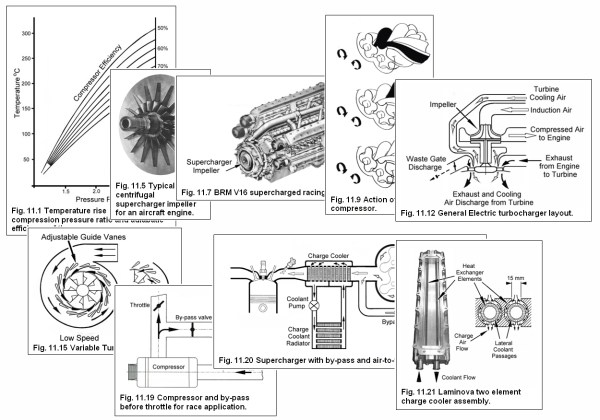Chapter 11. Supercharging and Turbocharging.
11118 words. 23 illustrations.

Compressor Efficiency. Charge temperature rise due to compression. Limitations without cooling.
Potential Performance Gain. 1980s turbo F1 engines pioneered by Renault. Produce well over 1000 b.h.p. from 1.5 litres. By 21st century could have been 2000 b.h.p. The Chrysler Hemi dragster engine.
Pre-war Aircraft Engine Progress. Schneider Trophy Racing Seaplanes. Supermarine S6B. Macchi-Castoldi MC72. Rolls-Royce 'R' engine. Merlin, Griffon descendents. Sir Stanley Hooker.
Aircraft Engine Compressors. Centrifugal and axial types.
Centrifugal Compressors for Car Engines. Exponential delivery. BRM V16 follies. Possible solutions.
Roots Blower. Non-compressive action. Consequent disadvantages.
Screw Compressor. Innovation by Lysholm. Advantageous working principle. High potential efficiency.
The Eaton TVS Blower. A modernised Roots more like a screw compressor. Improved efficiency.
Practical Considerations. Pressure changes with engine speed may not be linear. Importance of matching the blower to the engine system.
Turbocharging. Makes the centrifugal compressor more viable. Origins. GE aircraft engine turbocharger. Widespread use in WW2 US aircraft. Proposal for a 2500 b.h.p. 9 litre aircraft engine. Early car applications to Chevrolet Corvair and Oldsmobile F85. Methods of alleviating 'lag'. Turbo-Offy Indy race engine. Garrett Aireseach T3 designed for car engine sizes.
F1 Tubocharged Era. Amazing power outputs with gasoline fuel. Limits on boost pressure and fuel quantity result in outstanding fuel efficiency. Provoked development of sophisticated engine management and data systems. Pneumatic valve springs solve a problem.
Turbine Efficiency. Better close to the engine. Benefits from exhaust pulses. Most effective cylinder groupings. Variable Turbine Geometry.
Throttle Location. Throttle after a turbocharger. Throttle before a supercharger - mostly. Throttle after supercharger for very high performance. The need for by-pass systems. By-pass before throttle for racing engines.
Charge Cooling. Upper limit to charge temperature. Cooling effect of fuel - gasoline, methanol. Nitrous oxide. Evaporative cooling within blower. Practical considerations. Evaporative charge cooling in the cylinder with modern direct injection. Air to water charge cooling. Efficient Laminova cooler. Air to air charge cooling - better for ultimate power.
Other Considerations. Improving efficiency. Expansion ratio. Miller cycle.
Practical Matters. Port and valve sizes the same. Charge density increased not volume. Compression ratio - not too low.
Advanced Techniques. By-pass manipulation to permit higher compression. Resulting flatter torque curve.
Exhaust Emissions. Engine downsizing potential. Turbocharging virtues. Supercharging heats air from start-up. Good future for very low emission engines.
|